- Details
By Louie Stout
Fall walleye stockings in Pine and Stone lakes the past three years appear to be delivering positive results.
Indiana has stocked the two lakes “off and on” since 1990. However, the DNR and private groups have been consistently stocking larger fall fish in the connected lakes since 2021 with improved results.
Stocking numbers have been 4,926 in 2021, 6,172 in 2022 and 3,610 in 2023. While those numbers seem low, studies have shown that you get better results with low numbers of larger fish than you do with high numbers of tiny fish.
The fall fish sizes range from 4.8 to 6.2 inches when they go into the lake.
District fisheries biologist Tom Bacula conducted a survey there last fall and was pleased with the preliminary results.
“We found several year-one (2022) walleyes last fall and they looked good,” he said. “There’s a good chance anglers will begin seeing legal-size fish from the 2021 stocking this season.”
- Details
Mercury Report
 Prosciutto-Wrapped Walleye
Prosciutto-Wrapped Walleye
People love their walleye and for good reason. This freshwater fish, found in the northern United States and Canada, is easy to eat. Known for its mild and sweet flavor, the walleye is a favorite at countless fish fries as well as any number of festivals. You’ll find walleye on a stick at the Minnesota State Fair, and, of course, there’s the Mercury Marine National Walleye Tournament, which is part of the Walleye Weekend, an annual festival held in Fond du Lac, Wis.
For this recipe, Pat Kehoe, Director of International Partnerships at Ducks Unlimited Canada, a non-profit organization committed to the conservation of Canada’s wetlands and associated waterfowl habitats, shares his recipe for a simple, yet delicious, prosciutto-wrapped walleye.
- Details
Z-Man Report
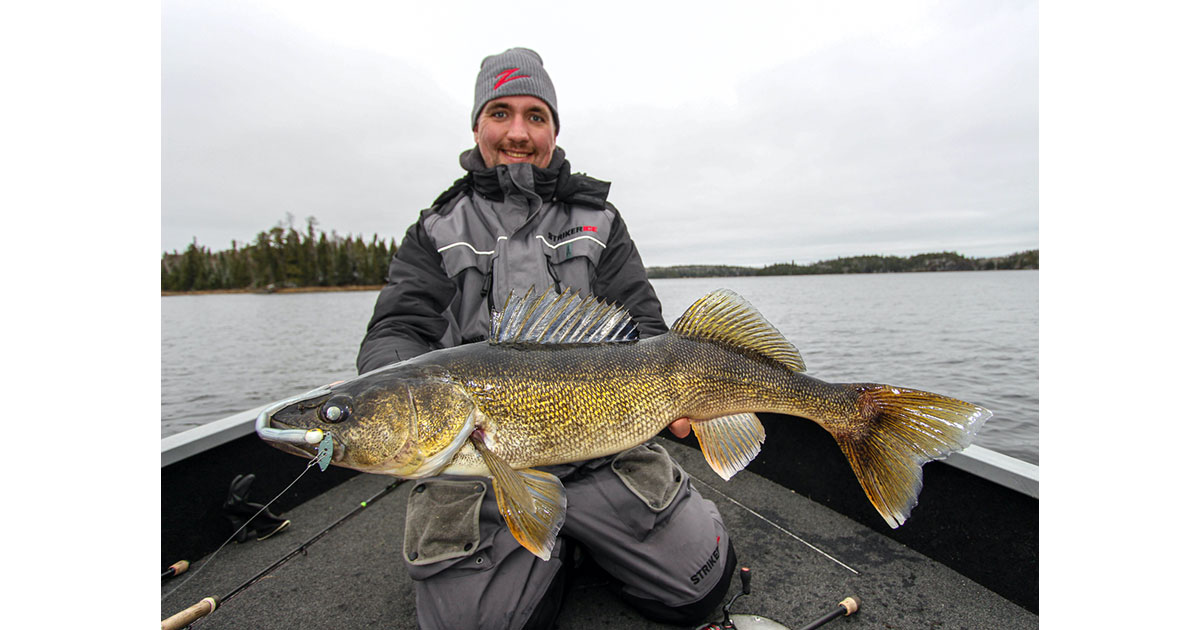 Large Walleye
Large Walleye
A walleye’s compulsion to attack ChatterBait® bladed jigs has become undeniable.
Paradoxically, bladed jig patterns also remain off-the-radar for most walleye anglers. You’ve either tried it, succeeded and quickly gone radio silent.
Recently, to discover the realities of walleyes and ChatterBaits, we probed the minds of several elite anglers, guides and tournament aces who’ve previously dropped hints about the lures everyone is wondering about, but few have discussed in the open. Their answers are nothing short of eye-opening.
“If you think about it, a ChatterBait bladed jig makes total sense for walleyes,” says Dylan Nussbaum, a tournament pro from Saint Marys, Pa. “Walleyes love vibration, they’re drawn to it and especially those lower frequency thumps and pulses. They almost always respond positively to flash—those reflective, scale-like visuals like the continuous on-off flicker of a lightbulb.”
Bladed Jig Breakdown
Beyond the flash and vibration and the silhouette of a trailing softbait, Nussbaum calls out one other key enticement, exclusive to a ChatterBait. “Some of the best walleye baits all share in common a rare ability to move erratically, randomly,” notes Nussbaum. “Look at the movements of a suspending jerkbait, for example. Or a heavy, jigging style glidebait. Both lures dart and slash in unpredictable directions—just as a live perch or minnow kicks and jukes unpredictably as they’re being hunted."
Even though anglers have been catching big walleyes on ChatterBaits for years, often by accident, walleye specialists continue underrating bladed jigs because they’ve been programmed to think of them in terms of bass only. But put the blade in the water and there’s no doubt walleyes sense it via lateral line—a ChatterBait likely emits the most powerful low frequency vibrations of any artificial lure.
- Details
By JEFF JOLLEY , MDNR Fisheries Manager
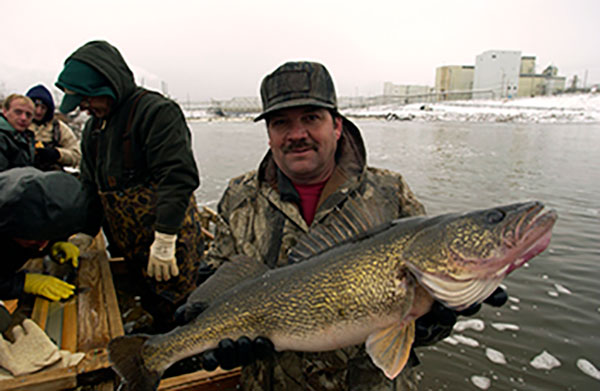 Saginaw walleye
Saginaw walleye
It’s springtime in Michigan, and cars, trucks and semis race toward Bay City and points north and south from Flint to metro Detroit. Some of those drivers might be heading to sunny shores and boat launches along Lake Huron.
If you find yourself as a passenger in a car traveling over the Zilwaukee Bridge on I-75, which rises over 100 feet above the Saginaw River, look at the surrounding landscape of eastern Michigan. If time allows, look closer. You will see some domed industrial buildings, and mountains of gravel and stone. There might also be some freighters and barges, as well as some smaller boats cruising the river’s mocha-colored water.
If it were possible, an even closer, deeper dive into the water would reveal a multitude of goldish-brown fish forming a ribbon in the distance. Any rays of sunlight able to penetrate the flocculence of the water reflect white off many pairs of fish eyes. It is the mighty walleye, cherished by many as the king fish of the Midwest. They are aptly named for the membrane over their eyes, in Latin called the tapetum lucidum, which reflects and focuses light.
Walleye are formidable visual predators in low light conditions. And there are millions of them. They come from Saginaw Bay and farther, from Thunder Bay, from Ontario, from southern Lake Huron. They have come for their annual migration to spawning grounds in the arteries of the Saginaw watershed – the Flint, Cass, Shiawassee and Tittabawassee rivers.
Predators of walleye
What nature giveth, nature taketh away. In the early 20th century, over 1 million pounds of walleye was annually harvested from Saginaw Bay. Then along came the alewife in the 1920s – it was a blessing and a curse.
Alewife invaded the Great Lakes when the Welland Canal opened so ships from the interior Great Lakes could bypass Niagara Falls and get to the Saint Lawrence River, the Atlantic Ocean and beyond. That also opened the door for fishes to swim in and colonize this new habitat.
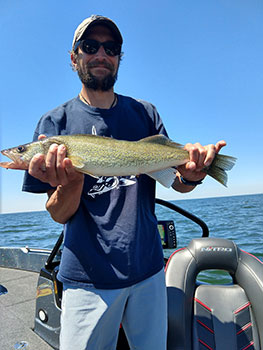 Saginaw walleyeAlewife fell in love with the Great Lakes, and we fell in love with the alewife. Here was the perfect fish food for the Chinook salmon, the new favorite hard-fighting, fast-growing and delicious-tasting focus of the sport fishery of the Great Lakes.
Saginaw walleyeAlewife fell in love with the Great Lakes, and we fell in love with the alewife. Here was the perfect fish food for the Chinook salmon, the new favorite hard-fighting, fast-growing and delicious-tasting focus of the sport fishery of the Great Lakes.
But the curse was that alewife eats baby walleye, and they eat all the things that baby walleye eat. A population explosion of alewife, along with a myriad of other factors, including overfishing and pollution, nearly drove the walleye to extinction.
But new players entered the story, namely zebra mussels and quagga mussels, and fundamentally changed the structure of the food web. These new mussels became the new stationary Roomba of the Great Lakes, and the power was always on. They are incredible at doing their job, which is filtering plankton from the water.
There is an adage among fishery scientists that might apply here: “He who eats the smallest thing, wins.” The alewife lost the food battle with the new mussels, and their population numbers plummeted. Another invader, the round goby, then entered the scene and has become a good alternate prey source for walleye.
Stocking walleye in Saginaw Bay
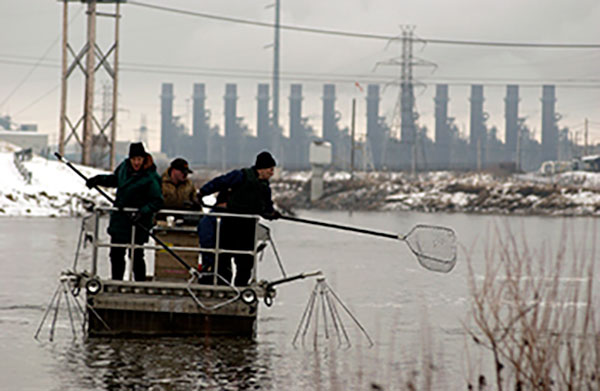 Walleye DNR Survey
Walleye DNR Survey
Attentive fisheries managers had been stocking many walleye into the bay to keep the population on life support over the years in the face of the massive alewife effects. The virtual disappearance of the alewife was what the walleye needed to survive. With their population rebounding, there are more than 5 million adult walleye in Saginaw Bay today, providing tremendous fishing opportunities.
The Saginaw Bay, Saginaw River and surrounding watershed have gone through a remarkable recovery. Environmental repair, protections and increased awareness have resulted in vast improvements in the health of the ecosystem. Dams have been removed, enabling walleye to make it to many of their former spawning grounds.
Water quality has improved, and egregious polluters have been dealt with, but the recovery is not complete by any means. There are visible scars of past environmental damage and some current open wounds. The basin is still considered an area of concern by the U.S. Environmental Protection Agency.
The disappearance of the alewife wasn’t enough; the walleye needed these improved environmental conditions, although a great deal of work remains.
Walleye fishing
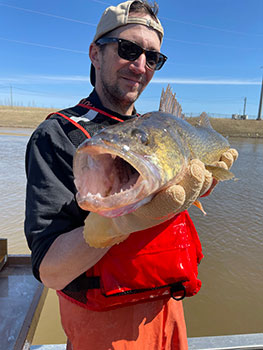 Walleye FishingThe Saginaw Bay/River fishery rivals that of any walleye fishery in the state and ranks up there with Lake Erie, the South Dakota impoundments, Dale Hollow, Lake of the Woods and Green Bay.
Walleye FishingThe Saginaw Bay/River fishery rivals that of any walleye fishery in the state and ranks up there with Lake Erie, the South Dakota impoundments, Dale Hollow, Lake of the Woods and Green Bay.
Today, walleye is the most sought-after fish in Saginaw Bay, owing partly to the great population recovery. The population keeps growing, and strong year-classes continue to be pumped out.
The limits are liberal – you can keep eight fish a day if they are 13 inches or larger. This year, for the first time ever, the Saginaw River from Saginaw (specifically the Center Street, or Douglas Schenk, Bridge) downstream to the river mouth is open to walleye harvest year-round!
Formerly the season was closed during about six weeks in March and April to let the walleye move through the river to their spawning grounds.
This is about 22 miles of river fishing for anglers to explore.
Learn more about walleye at Michigan.gov/Walleye and about Michigan fishing at Michigan.gov/Fishing.





